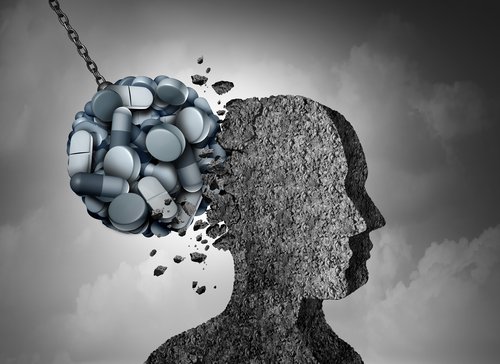Researchers are hard at work to end the opioid epidemic in the United States, where opioids cause 130 deaths every day.
Many people have found relief from their addiction through treatment centers, counseling, and support groups. But with more than 2 million Americans abusing opioids, experts are hoping to find a better way to help its victims.
A large part of their research has to do with how the brain responds to opioids. If they want to put a stop to the abuse, they have to know where the addiction starts.
The process is complicated, but it may lead to groundbreaking results that can end up saving millions of lives.
The deeper their studies go, the more it’s revealed that opioid use disorder (OUD) isn’t simply a matter of discipline and attitude.
Opioids can change your brain—literally. With enough abuse, your brain can start to look physically different.
Some of the effects are irreversible.
Here’s what we know about opioids and how they affect the brain:
What Makes Opioids Addictive?
It may sound hard to believe if you’ve never experienced it, but OUD makes you feel like you need opioids to live. They’re one of the most addictive classes of drugs.
An addiction can start at any time. It could be after your first time taking the drug, or it could be months down the line when you’re emotionally or mentally drained.
The intensity of the cravings can depend on the opioid. For example, heroin is known to immediately trigger intense cravings after the first time you use it.
But the effects on the brain are the same.
The culprit behind OUD is a brain chemical called dopamine. You produce this on your own every time something good happens.
Opioids trigger a flood of dopamine. When it wears off, the standard amount can pale in comparison. The result is an immediate craving for more. With long-term use, some people stop producing their own dopamine.
Experts found that opioids can get past cells that are supposed to keep molecules out of your brain. This makes its euphoric effects immediate and the risk for addiction higher.
How Opioids Change the Hippocampus
Opioids attack the brain’s hippocampus, which is a significant source of dopamine.
The hippocampus is responsible for our ability to learn and make memories. Manipulating the hippocampus is how opioids change reward processing directly in our brains.
Imagine yourself winning an award. When you learn the news, a small pathway opens up to give you a dose of dopamine. This is your brain’s way of naturally teaching you that doing good behavior has positive results.
Using opioids takes this process and multiplies it. This powerful drug creates a high by latching on to sources of dopamine and forcing it wide open to flood your brain with the chemical.
When your brain has more dopamine than usual, you get the feeling of intense euphoria.
But when the high is gone, you’ll feel worse than you did before using the drug. Soon your reward system won’t respond to anything except using drugs.
Withdrawal symptoms can be immediate and punishing. After their last dose, someone with OUD can easily experience the following:
- Muscle aches
- Fatigue and insomnia
- Depression and anxiety
- Nausea
- Fever
Because of the effect on your hippocampus, you’ll strongly associate feeling good with using opioids. That’s part of what makes them so addictive.
How Opioids Affect the Amygdala
Opioids have a strong effect on the amygdala. This is the part of our brain that processes emotions and rewards.
The amygdala is controlled by the brain’s logic center, the prefrontal cortex. The function of the prefrontal cortex is to help you make decisions and quell impulses. The amygdala helps process emotion and rewards.
When you have a dangerous impulse, the prefrontal cortex immediately lights up to knock some sense into the amygdala and the rest of the brain.
Opioids hijack this process. By shutting down the frontal lobe-amygdala connection that regulates your decision making, impulsive behavior takes the front seat.
Opioids destroy gray matter in the amygdala, which means it loses volume and gets smaller.
Do Opioids Damage Brain Cells?
When chemicals from opioids enter your brain, they attach themselves to your brain cells.
More specifically, they stick to elements on top of the brain cells called the opioid receptors.
These are useful when you’re using opioids to treat chronic pain. These receptors make sure that your medicine effectively addresses your condition.
But if you’re taking them for pleasure, they get less responsive. That means that:
- The drug itself will be less effective
- You won’t get the same feelings of euphoria at the same dose level.
This is called opioid tolerance. It motivates people with OUD to dangerously increase their doses.
With enough abuse, opioids can do direct damage to your brain cells. This can impair your brain from healing itself as you go through recovery. And it can lead to lifelong problems with cognition, executive function, and more.
But there are worse cases. In an overdose, you can stop breathing. This is the fastest way to kill brain cells through a lack of oxygen. Within minutes, an overdose can kill enough brain cells to cause death.
Do Opioids Make Your Brain Less Plastic?
The brain’s plasticity, or neuroplasticity, is the ability of brain cells to form new connections in response to learning or after injury.
People with OUD develop tolerance to opioids and drug-seeking behavior because their brain’s learn to only function correctly when there are opioids present. Without opioids, the entire nervous system can go haywire, causing a painful withdrawal syndrome.
In recovery, the brain is allowed to bounce back. But that lessens somewhat with time. The longer you put off OUD treatment, the worse your brain could be affected.
As long as opioids are present, you’ll continue to seek out the substance and use more.
Recovery is also more difficult when your brain is less plastic. The longer you abuse opioids, the harder it is to rewire your brain to function without them.
How This Information Can Change Opioid Treatment
Understanding how opioids interact with the brain can help us understand how to treat OUD. Scientists and researchers can use this information to stop addiction, right where it occurs.
Health professionals can also learn what makes a recovery so difficult in OUD cases. They’re now looking for medication-assisted treatments for OUD that doesn’t involve other opioids.
Drugs like naltrexone are an example, but patients can’t take it unless they’ve gotten past their withdrawal symptoms. This makes a lot of them give up on treatment, so researchers are working on finding other options.
There’s a worldwide community that’s keeping hope alive for people with opioid addiction. As a person with OUD, a loved one, or someone in recovery, anyone can use this information to spread awareness and understanding. OUD is more complex than even the medical community knows.
Sources:
- How opioid addiction alters our brains to always want more
- The Science of Addiction
- Withdrawing from Opiates and Opioids
- The Neurobiology of Opioid Dependence: Implications for Treatment
- Neuroplasticity in addictive disorders


